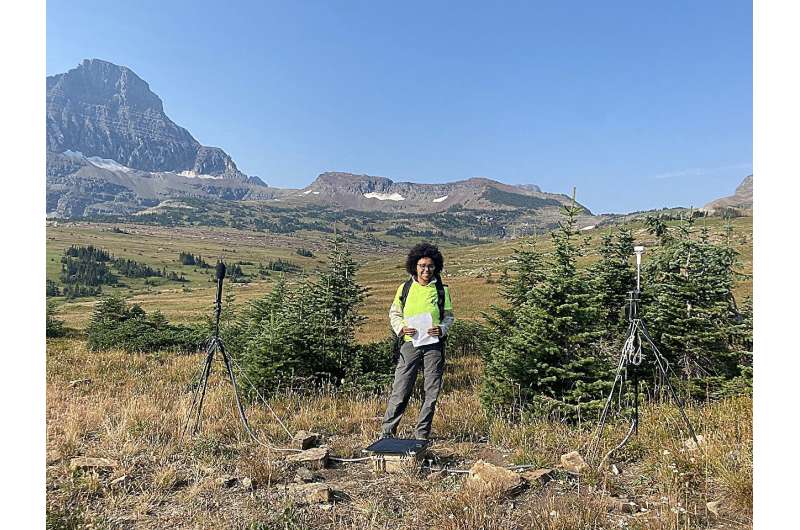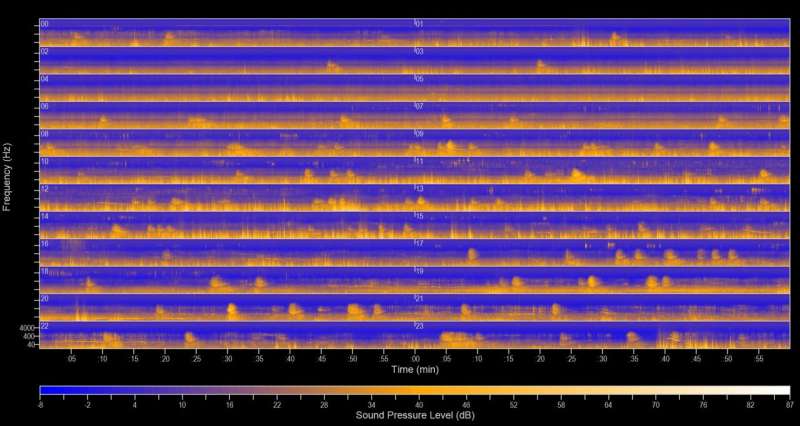This article has been reviewed according to Science X's editorial process and policies. Editors have highlighted the following attributes while ensuring the content's credibility:
fact-checked
trusted source
proofread
Measuring the changing soundscape in Glacier National Park

From the eerie echo of a bugling elk to the gentle swoosh of water lapping against a stony shore, a unique combination of sounds helps distinguish each national park. This acoustic environment, as perceived by humans, is known as a soundscape, and it is a vital attribute—albeit one that is increasingly under threat from anthropogenic noise.
Whether from the hum of an aircraft or human voices carried on a breeze, the unwanted intrusion of sound has the potential to adversely impact visitors and wildlife in natural areas. Now new research to be presented Tuesday at the annual meeting of The Geological Society of America documents how the acoustic environment in Glacier National Park has changed in the past 19 years—and what the implications are for protecting this unique resource.
"The focus of my project in Glacier was to conduct sound monitoring to see how the soundscape has changed, says Whitney Wyche, a Mosaics in Science intern who led the study. "Many visitors come to national parks to experience natural peace and the sounds of nature. To preserve this natural soundscape for future generations, it needs to be monitored and managed."
A baseline for assessing the impacts of noise
A growing body of research indicates that noise affects both marine and terrestrial wildlife, causing animals to alter vocal and foraging behaviors, reducing the abundance of species in noisy habitats, and impacting the structure of ecological communities. Noise can also affect how wildlife navigate the landscape, from mating to locating prey to other communications crucial for wildlife to survive.
"A predator that can hear sounds within a radius of 9 m2 in a natural soundscape would only be able to hear sounds within a radius of 7 m2 if one decibel of sound was added to the natural soundscape," wrote Wyche in an internship blog.
"My project, which is a continuation of a soundscape project in Glacier from 2004, can provide more information about the natural soundscape," added Wyche, who recently graduated from Franklin & Marshall College with a bachelor's degree in environmental science.
The 2004 research was conducted in Glacier by the Federal Aviation Administration, the National Park Service, and the Volpe National Transportation Systems Center. The project established a baseline for the park's natural soundscape from which potential noise impacts could be assessed, including from aircraft operations over and near the park.
At that time, aircraft were a growing concern—especially scenic helicopter rides that originated outside the park boundary but that intruded on the natural soundscape across a wide area, particularly affecting hikers and backpackers.
In 2019, students from Worcester Polytechnic Institute investigated the soundscape at some of the same sites as the 2004 baseline study. They found that aircraft noise remained about the same.

Air tour management plan
But the results of Wyche's study are different. This is due in part to the fact that the number of commercial air tours has decreased since 2004 as a result of restrictions from the park's new Air Tour Management Plan, whereas the number of visitors has increased by about 50%. These changes have had mixed impacts on the park's acoustic environment, according to Wyche and her co-authors, Jillian McKenna and Damon Joyce, who both work for the park service.
Completing an air tour management plan is a long process, and having acoustic data available before and after Glacier's plan was completed is noteworthy, according to Wyche. "It's exciting to be the next step in the research process by conducting acoustic monitoring after the plan was put into place," says Wyche.
To monitor Glacier's changing acoustic environment, the intern set up monitoring equipment, including a sound level meter, digital audio recorder, and meteorological equipment, at sites around the park for two weeks per site. Wyche then used software from the park service's Acoustic Monitoring Toolbox, including the Sound Pressure Level Annotation Tool, to identify sound sources by analyzing spectrograms by highlighting sound sources based on their visual signature.
"The percentage of time with audible propeller aircraft remained similar at sites near the current air tour route, while decreasing at Logan Pass, which is not near the currently authorized air tour route," says Wyche.
Future steps include continuing the acoustic monitoring to extend the record of the park's changing soundscape, according to Wyche. This will be especially important as the park phases out commercial air tours by the end of 2029. "Monitoring how Glacier National Park's soundscape has changed will help inform park management on what threats to the natural soundscape need to be mitigated," says Wyche.
Wyche worked in Glacier National Park during the summer of 2023 as part of the Mosaics in Science Diversity Internship Program, which provides college students and recent graduates who are underrepresented in STEM (science, technology, engineering, and math) career fields with on-the-ground, natural resource science-based work experience in the National Park System. The program is operated in partnership with Environment for the Americas .
"I greatly enjoyed my experience working as a Mosaics in Science intern," says Wyche. "I especially appreciated the goal of the internship program because it makes environmental careers more accessible to people of color."
More information: Paper presentation: gsa.confex.com/gsa/2023AM/meet … app.cgi/Paper/395164
Provided by Geological Society of America




















